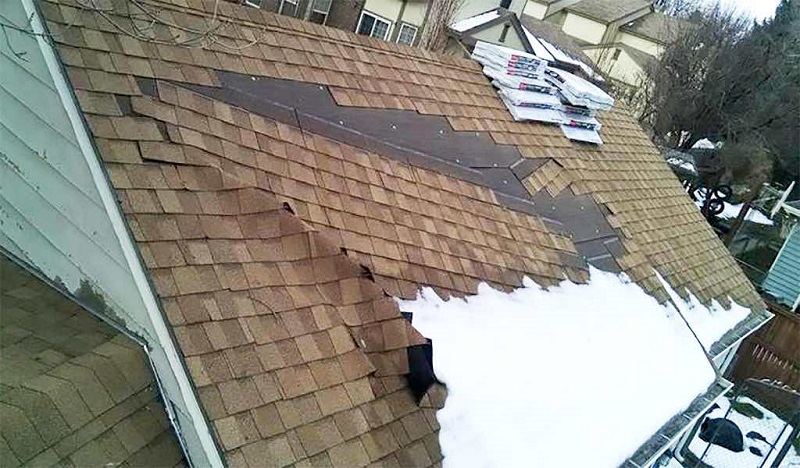When it comes to roof replacements we’ve seen it all. From bad to worse installations, we have been called to come and fix what another company or homeowner has done incorrectly. From all of our experiences, we have noticed some styles and want to share some of these with you and that means you can avoid them and save yourself a major headache.
Starter shingles missing or installed incorrectly. This is a common do-it-yourself mistake. It’s very important to lay down a starter section of shingles near the eaves. If you miss this step, water will inevitably enter the sheathing beneath the shingles’ cutouts. ROOFING Ann Arbor Michigan, This contributes to leaks, snow dams, ruined shingles and much more damage down the road. Incorrect nailing. Shingles slip and shift around if they are not nailed in the exact right location, or if too few nails have been used. This can be due to a laborer rushing or being too sloppy with their work. Most shingles require at least 4 nails per shingle if it’s not a steep grade. Nails should be put through the nailing strip and not come into contact with the self-sealing portion of the shingle. This can lead to leaks and roof failure if done improperly. It’s also difficult to trace because nail placement affects every shingle on your roof and water can travel a long way before being recognized inside your house.
Improper air flow. Ventilation is important for roofs because it can affect dampness buildup and cause an entire roof to fail prematurely if done incorrectly. This includes an overall attic plan to ensure the airflow needs are met, which may include adding a new ridge vent, eave venting, baffles to avoid obstructing attic airflow and dealing with any other areas where “short-circuiting” may be happening. Short-circuiting occurs when there is an incorrect gable or package vent that is allowing airflow to travel a shorter distance, which leads to ineffective attic air flow. This is easy to mess up and is very common among low-cost, low-quality roofer companies.
Wrong slope. Selecting the right material for the slope of the roof is vital to a quality roof installation. The wrong selection leaves the roof open to water penetration. If installing an asphalt roof, the minimum amount slope is 4 models of rising per 12 models of the run. Asphalt shingles cannot securely tolerate a lesser slope than that.
Incorrect shingle alignment. This is one of the easiest tell-tale indicators of shoddy roof workmanship. When the cutout on a three-tab shingle is not placed vertically or the butted bones are not on the same horizontal aircraft, the shingles are not aligned properly. This contributes to accelerated shingle wearing, more prevalent leaking and eventually premature roof failure. And it’s easy to spot!
No plan for snow dams. Here in Michigan, snow damming is common. They happen when the snow melts on the roof and then refreezes, which can pressure water underneath the shingle where it can pull shingles up and add unneeded weight to your eaves and gutter system. We prevent snow damming by putting our Pro Snow and Water Shield down along the end of the roof to prevent water from infiltrating in that ice-dam susceptible area. Missing this step can save a business money, but will cost you money down the road.
Incorrect securing of valley flashing. Roof valleys are highly prone to leaks because they handle so much runoff water. Not securing the flashing properly using sealant and securing materials can lead to buckling and failure of the flashing. It’s easy to miss and do incorrectly unless you have highly-trained installers.
Incorrect installation of valley flashing. The other aspect of valley flashing that is so important is the valley flashing installation. Flashing needs to be layered underneath shingles properly, never laid on top of shingles. The U-shape of the metallic on the flashing should face the valley. Without the correct installation, water will quickly find the point of weakness and rate the deterioration of your shingles, flashing, and roof.
Wrong shingle exposure. For a typical three-tab shingle, exposure of five INS is commonly suggested. If this is shortened whatsoever, this leaves the roof open to collecting dampness during a storm, rather than dropping it. It will also be susceptible to being blown off if there is every a high-speed wind storm.
Wrong shingle overhang. The end of a shingle should hang over a roof between 1 to 1 1.5 inches, or between 0.5 and 0.75 inches if the drip edge flashing is installed. Too little overhang allows water to run into fascia boards. Too much overhang and the shingles are susceptible to blow off during high winds. Since this is a game of inches, it is important to be precise and not leave this type of thing to chance.
Roofing can seem just like a laborious job where the task is to remove old shingles, simple and install new. But without considering the finer points required by the type of roof, the attic, the slope, the weather and the material to be used, it can be easy to mess up the details leading to a massive out-of-pocket cost in the future. This is why relying on low-quality roofer companies without a great track record can be cheaper in the immediate term, but they will likely miss the details and leave you with an unsatisfactory result. If you would like help getting your roof replaced by proven experts, call us.
